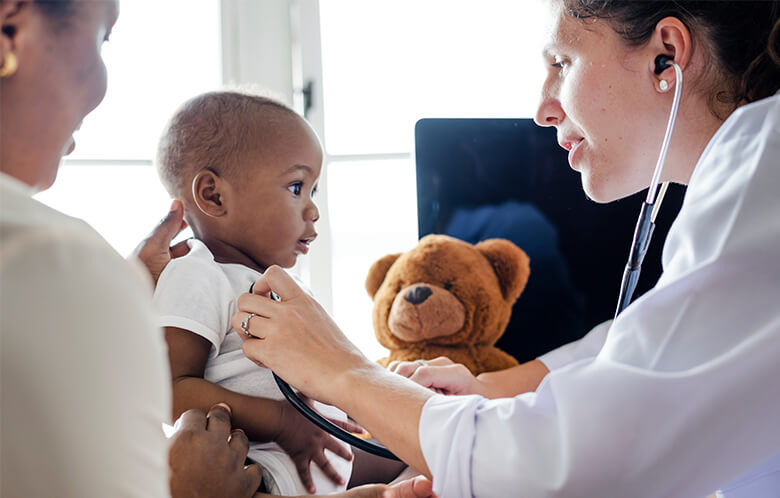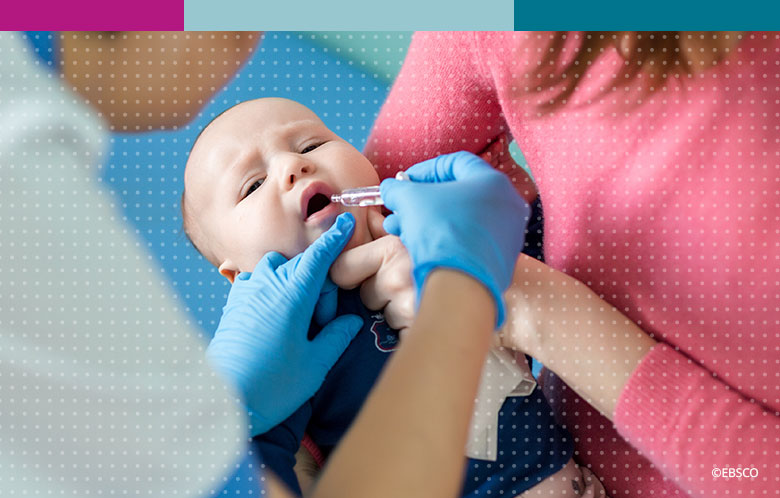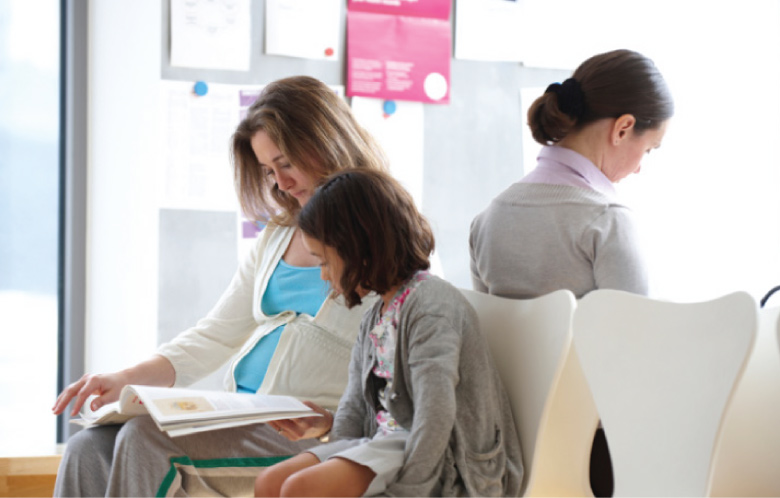Respiratory syncytial virus (RSV) is one of the most common causes of respiratory infection, especially among infants and children. This cold/flu season, RSV hospitalizations are rising earlier than usual and in numbers greater than peak levels seen prior to the COVID-19 pandemic. Here DynaMed answers 10 common questions about RSV.
1. Is RSV just a childhood disease?
While nearly all people acquire their first RSV infection under the age of two, reinfection can occur multiple times and across all age groups, including adulthood. Actual incidence rates of infection are unknown because most people are not tested.
2. What is the clinical course of RSV infection?
Early RSV infection is characterized by upper respiratory symptoms including congestion, rhinorrhea, and fever. The disease is usually mild and self-limited in older children and adults. If the infection progresses into the lower respiratory tract, however, inflammatory lung injury (clinically referred to as bronchiolitis) may develop, causing symptoms such as cough, tachypnea, and increased respiratory effort with chest retractions and wheezing.
3. What are the risk factors for developing bronchiolitis?
For infants, risk factors for bronchiolitis include age under 12 weeks, prematurity, lack of breastfeeding, in utero smoke exposure, and disorders affecting cardiopulmonary development such as bronchopulmonary dysplasia or congenital heart disease, as well as immunodeficiency.
Severe illness is uncommon in adults. However, some groups may be at risk for developing lower respiratory tract disease due to RSV infection; these include persons over 65 years of age, those with immunodeficiency, and those with cardiopulmonary disease, such as COPD.
4. What causes respiratory distress in RSV bronchiolitis?
One of the hallmarks of RSV bronchiolitis is submucosal edema and swelling that leads to mucus production and airflow obstruction. Since an elevated inflammatory response is associated with severity, it is hypothesized that the infant immune system may skew away from a protective type 1 antiviral response to a type 2 response causing elevated mucin production. As mucins are glycosylated proteins produced by epithelial cells that form gels for lubrication and barrier formation, excessive airway mucus in the not-fully-developed lungs of infants causes respiratory distress in RSV bronchiolitis.
5. How is RSV differentiated from other respiratory viruses?
The only sure way to differentiate RSV from other respiratory viruses is by viral testing. This is accomplished using a polymerase chain reaction (PCR) test to detect genetic material or a rapid antigen test. Viral testing is often performed in a multiplex assay that checks for several viruses (such as RSV, influenza, and SARS-CoV-2) from a single sample.
Prior to the COVID-19 pandemic, viral testing was not routinely performed for people with respiratory infection, even those with bronchiolitis, because a confirmatory result did not change management. Since the COVID-19 pandemic, most hospitalized patients are routinely tested for all three viruses to inform treatment options, isolation requirements, and to help predict the clinical course, which differs slightly between the viruses.
6. How is RSV bronchiolitis managed?
Supportive care is the mainstay of therapy for RSV bronchiolitis and includes rehydration, supplemental oxygen, and antipyretics as needed. Bronchodilators (such as nebulized epinephrine) and corticosteroids are NOT routinely recommended due to limited evidence for their efficacy. Inhaled corticosteroids may be used in certain circumstances, such as control of asthma. Bronchodilator therapy may benefit adults with COPD and RSV infection. There is insufficient evidence for the use of antivirals such as ribavirin.
7. Why can people get RSV multiple times?
People can get RSV multiple times throughout their lives because the immune response to RSV infection is not fully protective. While there are various strains of circulating RSV, people can be reinfected with the same strain. Partial immunity from prior infection cannot completely prevent illness from RSV, but it likely lowers the risk of severe disease in older children, adolescents, and adults.
8. Without an approved RSV vaccine, what progress has been made in prevention?
There have been several failed attempts at development of a vaccine to prevent RSV infection and while there are a number in clinical trials, no RSV vaccine is currently approved for use. Three primary strategies are being tested for prevention of RSV: protein-based vaccines for pregnant individuals (for passive immunity to neonates), monoclonal antibody prophylaxis for neonates, and live-attenuated vaccines for infants.
According to a press release from Pfizer, their prefusion F protein-based vaccine administered to pregnant individuals reduced RSV infections among babies in their first 90 days of life. A few other RSV vaccines are in phase 3 trials and options for maternal vaccination are expected to be available soon.
Palivizumab is a monoclonal antibody that targets the F surface glycoprotein of RSV. A Cochrane review of five randomized trials showed that palivizumab decreased hospitalization for RSV infection in infants and children under two years of age. It is recommended for infants at high risk for bronchiolitis. A newer monoclonal antibody, nirsevimab, has also been shown to be effective in healthy preterm infants in a randomized trial.
9. Are there other ways to prevent RSV infection?
Public health measures implemented during the COVID-19 pandemic drastically reduced RSV infections during the 2020-2021 cold/flu season. While measures such as school closures are not intended as long-term or even seasonal solutions, masking and improving ventilation may be helpful in reducing the incidence of many respiratory virus infections, RSV included.
10. Why is pediatric RSV so bad this year?
There are several theories as to why pediatric ICUs are full of infants and children with RSV this year. One hypothesis known as “immunity debt” postulates that the decline in RSV infections in 2020-2021 due to precautionary measures taken during the COVID-19 pandemic may have resulted in a more susceptible population.
It is likely that the rise in RSV cases this year is due to a combination of factors that also includes a dramatic increase in routine testing, the loosening of pandemic-related containment measures, and possibly the immunologic effects of COVID itself (even among children with mild illness). All of these factors would contribute to higher incidence of RSV this season, and potentially to greater severity.



